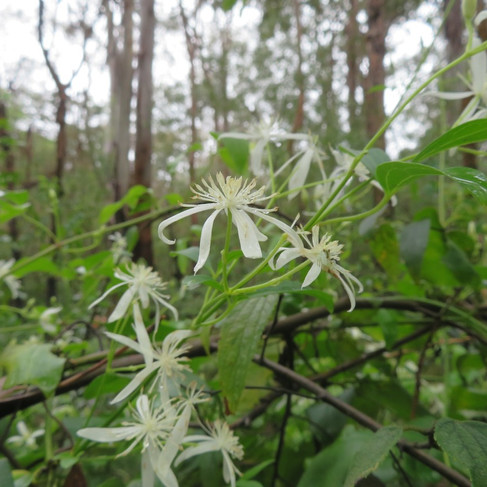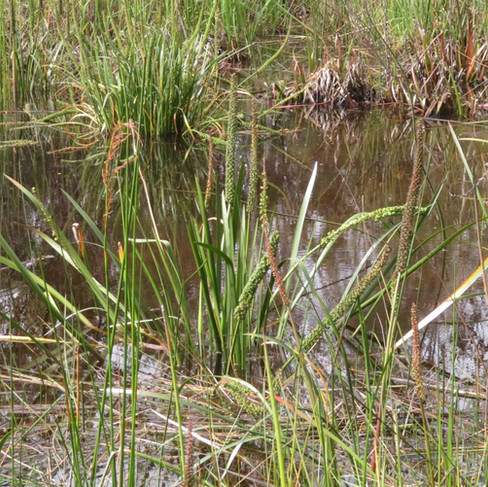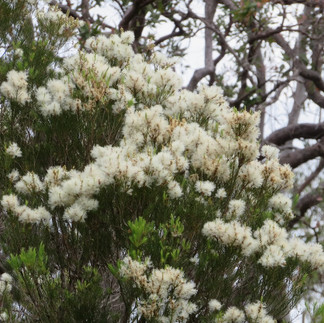Letter from Istari - December 2022
- Ian
- Dec 4, 2022
- 5 min read
Updated: Dec 6, 2022
Spring is gone. The days are heating up, the goannas are out and about.
Bells phase Goannas

We have noticed two Bells Phase lace monitors around lately, the one shown above, and a much younger one. It is great to see them. The Bells phase displays different colour bands compared to the usual lace monitor but it is the same species. The one in the photo is about to molt so the colours are not vivid.
Rain Update
The winter was mild and fairly dry, we had only 44mm (average is 146mm) for the whole season, which was a good thing given the amount of rain earlier in the year. By the end of August we had over 500mm more than the annual average total.
Everything dried out with so little rain in winter and the grass browned but spring brought back a lot of rain, more than average for September and October, and everything is now very green.
November has been quite dry though and the wetland has stopped overflowing but with a little more rain it will run again. The possibility of yet another La Nina this summer leaves the region nervous.
Bandicoots
The ground is full of diggings from our bandicoots. They seem to have reproduced well as we have never seen so many holes through the forest. The wonderful animals dig a conical hole in search of grubs, worms and insects or even fungi and tubers.
The bandicoot we see here is the long nosed bandicoot (Perameles nasuta). These are nocturnal but can come out before dark if you are lucky. They are much larger than a rat, which is how they look at first glance.
These animals are marsupials though and are not related to rodents. As a marsupial they raise their young in a pouch like kangaroos and wallabies but due to their digging their pouch faces backwards to stop the soil or sand ending up in the pouch.
Caught on Camera
We have continued use our wildlife camera to monitor the wildlife and particularly look out for feral pigs, of which there have been few this winter fortunately. We put out a little grain to attract the pigs to the surveillance area and inevitably attract some of the wildlife too. The wallabies are the usual culprits but this season we notice more bandicoots as well. We were most delighted to identify two other animals we didn't know about.
Short eared brushtail possum

The short eared brushtail possum (Trichosurus caninus) appeared first. This possum is darker than the usual brushtail we often come across.
It is one of the largest arboreal marsupials, about cat sized and up to 4kg. It is territorial so this one will be around again.
For some fantastic photos of these adorable animals check out this site and scroll down.
Thanks to Dave Sharpe for the identification.
Melomys

As well as this possum we also photographed an animal we had no idea existed, a melomys. There are many species in this genus, ours is the fawn-footed melomys (Melomys cervinipes).
It is a native rodent about the size of a rat. It has no fur on its tail which is longer than its body.
Thanks to Daniel from our weed team for identifying this little native rodent.
Black Swams
We were fortunate enough to see black swams with five young in a wetland on the road to Istari. We managed to get a couple of photos. See our mini blog for more
Spring Flowers
The spring flowering was wonderful. Check out our gallery of spring flowers in our bush.
Egg and Bacon Pea
Egg and Bacon Pea (Dillwynia retorta) is a shrub about 1 metre tall and has beautiful pea like flowers.
Three-nerved willow hakea
Hakea florulenta has magnificent flowers. It is a shrub which mainly grows in open forest areas to a height of 1-2 metres. The flowers grow along the stems of the plant producing a magnificent display. The seeds form hard shells.
Travellers joy
Travellers joy (Clematis glycinoides) is a vine found near streams. It produces a beautiful display of flowers in the spring with a wonderful scent. These vines can form large trunks growing up the tree.
Blue Dampiera
Blue Dampiera (Dampiera syvestris) is a perennial which grows low in an open forest. It flowers a lot of the year but mostly in spring and is putting on a magnificent display this year.
Water ribbons
Water ribbons (Cycnogeton procerum) is a water plant that grows in the wetland. It has strap like leaves, hence the common name of water ribbon. The small flowers appear along the stem.
Crinkle bush
Crinkle bush (Lomatia silaifolia) produces lots of flowers along the stem. The plant grows here in a open forest. It grows to 1-2 metres high as a small shrub. The leaves are similar to grevillea and does belong to the same family.
Elbow Orchid
Elbow Orchid (Arthrochilus prolixus) is a small orchid you might not even notice on the forest floor. The flower stem reaches about 30cm in height. The flowers are insect like.
The best way to see this delicate flower in the photo is to click on the photo and see it magnified.
Slender wire lily
Slender wire lily (Laxmannia gracilis) is a small herb with a delicate white and sometimes pink flower. The flower is tiny.

Little hatpins
Little hatpins (Eriocaulon scariosum), also known as Rough pipewort, are the smaller version of the large hatpin (Eriocaulon australe). These two plants get their common name from the flower sitting at the end of a long stalk resembling a hatpin. These little hatpins only stand 15-80mm high as opposed to the large hatpins which stand up to 60cm high.
Snow in Summer
Snow in Summer (Melaleuca linariifolia) is a beautiful paperbark tree which flowers in late spring and early summer depending upon where the tree is growing. The white flowers tend to form on the tops of the trees and look like snow sitting on the top of the tree. This can form a spectacular show. This is also the plant used to produce tea tree oil.
Endangered plant thrives
The slender screw fern (Lindsaea incisa) is a small fern that is endangered in NSW. We had identified this plant here many years ago but it has been set back by fires and the drought but we are happy to say that it has grown back well and we have found a second colony of the plant. It is a pretty fern liking moist places. This colony is right near one of our wetlands.
Eternovy Wetland
Our closest wetland is quite large and Terry has been busy photographing this stunning wetland. The wetland is named in honour of Ivan Ternovy who purchased this land back in the 1980s with myself. He sadly passed away way too early in the 1990s so in memory of his life we have named this wetland Eternovy.
Weed control
We managed to get another grant through our local environment centre to assist with the control of cats claw creeper vine and other weeds along our main creek. The grant comes from WWF specifically to improve this land as a koala habitat, especially after the fires in the region.
We worked with the Clarence Environment Centre to obtain the grant and thank Pat Edwards for her efforts on this. We used the weed team from the environment centre to carry out the work. They did a fantastic job ensuring the cats claw is stopped from running up the tree.
After the vine below reshot we went back and sprayed herbicide on the new shoots which is more quickly absorbed into the plant.
Redbubble Shop Now Open
We have added a few of our photographs to the Redbubble shop so you can now purchase these as any number of products with these photos including
canvas prints in different sizes
photographs
T shirts
stickers and postcards
lot of other products
Any profits made from the sale of these will go towards the our continuing fight to rid weeds and other ferals on or near Istari.
Check out the our Istari shop at Redbubble
Have a wonderful summer
To all our friends we wish you a wonderful summer. Stay safe and enjoy.
Some links





































































ความคิดเห็น